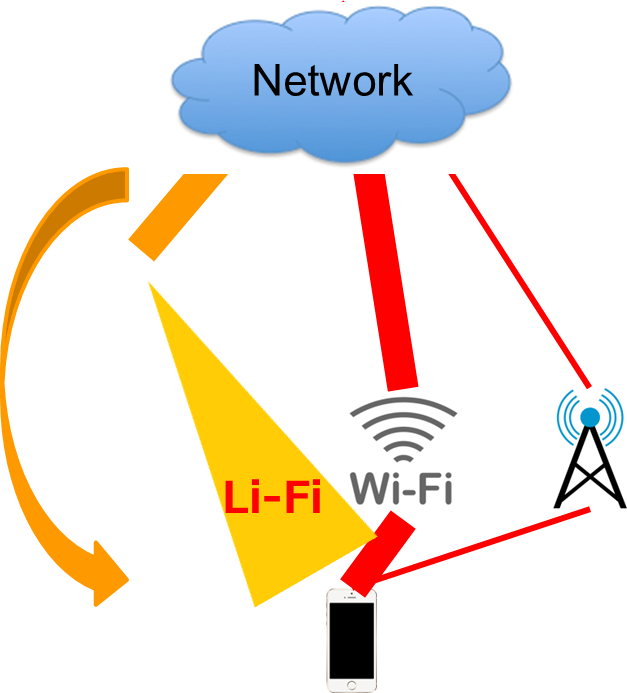Research
About RYU Laboratory
Ryu Laboratory (Ryu Labs) started research on April 2016 immediately after
S. Ryu joined Meiji University.
Ryu Lab is conducting research on optical fiber communication systems,
optical wireless communication systems, and optical fiber-related measurement
technologies.
The laboratory is located on the Nakano Campus of Meiji University, which is close to JR Nakano Station, to conduct cutting-edge research in an environment.
Research fields
 The current research focuses on the following contents.
The current research focuses on the following contents.
1. 1. Research on optical wireless communication systems
2. Research on long-distance coherent optical fiber communication systems
3. Research on optical measurement technology
1. Optical Wilreless Communication Systems
 Due to the development of video distribution services, the current mobile phone network has insufficient communication capacity with only the originally allocated radio frequency resources, and the Wi-Fi network is used as a means to supplement this.
Due to the development of video distribution services, the current mobile phone network has insufficient communication capacity with only the originally allocated radio frequency resources, and the Wi-Fi network is used as a means to supplement this.
However, at event venues and train stations where many people gather, even if Wi-Fi is used, the communication capacity is tight.
As a means to overcome this situation, we are researching an optical wireless
communication method that puts data for mobile phones on the light emitted
from familiar lighting. Since the data is placed on the light, the coined
word 'Li-Fi', which replaces the 'L' in the English word 'Light', which
represents light, with the 'W' in 'Wi-Fi' has also appeared, and is a technology
that has been attracting attention these days.
However, since optical wireless communication technology uses spatial propagation
of light, there is an essential problem that communication is blocked if
there is something that physically blocks it. Therefore, in order to overcome
such problems, our laboratory is studying the diversity transmission/reception
method. We are also conducting research on MIMO (Multi-Input Multi-Output)
technology for the purpose of increasing the capacity and functionality
of optical wireless communication systems. MIMO technology has already
been put to practical use in wireless communication technology, but our
laboratory is conducting research to apply it to optical wireless communication
systems.
2. Long-haul coherent optical fiber communication systems

Research on long-haul high capacity systems has been improved significantly
recetly. Using the present state-of-the-art digital coherent optical communication
systems technology, 100-Gbit/s per wavelength using QPSK format and 200-Gbit/s
per wavelength using 16QAM format have been commercialized. Coherent optical
communication systems use optical phase of light to carry data streams.
Coherent optical communication systems using optical phase modulation is
essentially susceptible to optical phase noise caused by, e.g., optical
fiber nonlinearities. Optical phase noise have not been paid so much attention
in traditional optical communication systems since the systems just used
'intensity modulation' of light.
We are doing research on optical phase noise caused in the fibers to clarify
the effect of the phase noise characteristics on the transmission performance
Furthermore, as the capacity of coherent optical fiber communication systems increases, the power consumption of the electronic circuits used in the systems has become problematic, and technology to reduce the burden on the global environment is required.
To address this problem, using all-optical circuits that process only optical signals instead of electronic circuits can significantly reduce power consumption compared to when electronic circuits are used.
Please see this article for more information on reducing power consumption using all-optical circuits
(Meiji University website).
3. Optical Measurement Technology
Coherent heterodyne detection technology has long been used in the field
of optical measurement technology, but analog signal processing has been
the main focus. However, since the 21st century, when research on digital
coherent optical communication methods has become active, research on applying
digital signal processing to optical measurement technology has become
active.
By using digital signal processing, so-called offline processing has become possible, and it has become possible to actually confirm phenomena in optical fibers that were previously invisible.
In our laboratory, we are conducting research on measurement technology that combines coherent heterodyne detection technology and digital signal processing. In particular, we are focusing on the following research.
・ Rayleigh scattered light measurement technology
strain measurement, vibration measurement, birefringence distribution
measurement due to stress applied to optical fiber
・ Brillouin scattered light measurement technology
strain measurement and vibration measurement due to stress applied to
optical fiber
Ryu Laboratory
School of Interdisciplinary Mathematical Sciences
Meiji University
Room 1207, 1208
4-21-1, Nakano, Nakano-ku
Tokyo 164-8525, Japan